Assessment of AIRS Version 7 Temperature Profiles and Low-Level Inversions with GRUAN Radiosonde Observations in the Arctic
Abstract
1. Introduction
2. Data and Methods
2.1. AIRS Level 2 Data
2.2. GRUAN Upper-Air Measurements
2.3. Method of Validation
3. Results
3.1. Intercomparison between the AIRS and Radiosonde Temperature Profiles
3.2. Seasonal Variability of the AIRS Temperature Bias
3.3. Detection of Low-Level Temperature Inversions
3.4. Assessment of the Accuracy of the AIRS Inversion
4. Discussion
5. Conclusions
Author Contributions
Funding
Data Availability Statement
Conflicts of Interest
References
- Constable, A.J.; Harper, S.; Dawson, J.; Holsman, K.; Mustonen, T.; Piepenburg, D.; Rost, B. Cross-Chapter Paper 6: Polar Regions. In Climate Change 2022: Impacts, Adaptation and Vulnerability. Contribution of Working Group II to the Sixth Assessment Report of the Intergovernmental Panel on Climate Change; Pörtner, H.-O., Roberts, D.C., Tignor, M., Poloczanska, E.S., Mintenbeck, K., Alegría, A., Craig, M., Langsdorf, S., Löschke, S., Möller, V., et al., Eds.; Cambridge University Press: Cambridge, UK; New York, NY, USA, 2022; pp. 2319–2368. [Google Scholar] [CrossRef]
- Rantanen, M.; Karpechko, A.Y.; Lipponen, A.; Nordling, K.; Hyvärinen, O.; Ruosteenoja, K.; Vihma, T.; Laaksonen, A. The Arctic Has Warmed Nearly Four Times Faster than the Globe since 1979. Commun. Earth Environ. 2022, 3, 168. [Google Scholar] [CrossRef]
- Goosse, H.; Kay, J.E.; Armour, K.C.; Bodas-Salcedo, A.; Chepfer, H.; Docquier, D.; Jonko, A.; Kushner, P.J.; Lecomte, O.; Massonnet, F.; et al. Quantifying Climate Feedbacks in Polar Regions. Nat. Commun. 2018, 9, 1919. [Google Scholar] [CrossRef] [PubMed]
- Previdi, M.; Smith, K.L.; Polvani, L.M. Arctic Amplification of Climate Change: A Review of Underlying Mechanisms. Environ. Res. Lett. 2021, 16, 093003. [Google Scholar] [CrossRef]
- Serreze, M.C.; Barry, R.G. The Arctic Climate System, 2nd ed.; Cambridge Atmospheric and Space Science Series; Cambridge University Press: Cambridge, UK, 2014; ISBN 978-1-107-03717-5. [Google Scholar]
- Pithan, F.; Mauritsen, T. Arctic Amplification Dominated by Temperature Feedbacks in Contemporary Climate Models. Nat. Geosci. 2014, 7, 181–184. [Google Scholar] [CrossRef]
- Stuecker, M.F.; Bitz, C.M.; Armour, K.C.; Proistosescu, C.; Kang, S.M.; Xie, S.-P.; Kim, D.; McGregor, S.; Zhang, W.; Zhao, S.; et al. Polar Amplification Dominated by Local Forcing and Feedbacks. Nat. Clim. Chang. 2018, 8, 1076–1081. [Google Scholar] [CrossRef]
- Bintanja, R.; Graversen, R.G.; Hazeleger, W. Arctic Winter Warming Amplified by the Thermal Inversion and Consequent Low Infrared Cooling to Space. Nat. Geosci. 2011, 4, 758–761. [Google Scholar] [CrossRef]
- Kaufman, Z.S.; Feldl, N. Causes of the Arctic’s Lower-Tropospheric Warming Structure. J. Clim. 2022, 35, 1983–2002. [Google Scholar] [CrossRef]
- Kahl, J.D. Characteristics of the Low-Level Temperature Inversion along the Alaskan Arctic Coast. Int. J. Climatol. 1990, 10, 537–548. [Google Scholar] [CrossRef]
- Serreze, M.C.; Kahl, J.D.; Schnell, R.C. Low-Level Temperature Inversions of the Eurasian Arctic and Comparisons with Soviet Drifting Station Data. J. Clim. 1992, 5, 615–629. [Google Scholar] [CrossRef]
- Bourne, S.M.; Bhatt, U.S.; Zhang, J.; Thoman, R. Surface-Based Temperature Inversions in Alaska from a Climate Perspective. Atmos. Res. 2010, 95, 353–366. [Google Scholar] [CrossRef]
- Miller, N.B.; Turner, D.D.; Bennartz, R.; Shupe, M.D.; Kulie, M.S.; Cadeddu, M.P.; Walden, V.P. Surface-Based Inversions above Central Greenland. J. Geophys. Res. Atmos. 2013, 118, 495–506. [Google Scholar] [CrossRef]
- Palo, T.; Vihma, T.; Jaagus, J.; Jakobson, E. Observations of Temperature Inversions over Central Arctic Sea Ice in Summer. Q. J. R. Meteorol. Soc. 2017, 143, 2741–2754. [Google Scholar] [CrossRef]
- Wang, D.; Guo, J.; Xu, H.; Li, J.; Lv, Y.; Solanki, R.; Guo, X.; Han, Y.; Chen, T.; Ding, M.; et al. Vertical Structures of Temperature Inversions and Clouds Derived from High-Resolution Radiosonde Measurements at Ny-Ålesund, Svalbard. Atmos. Res. 2021, 254, 105530. [Google Scholar] [CrossRef]
- Zhang, L.; Li, J.; Ding, M.; Guo, J.; Bian, L.; Sun, Q.; Yang, Q.; Dou, T.; Zhang, W.; Tian, B.; et al. Characteristics of Low-Level Temperature Inversions over the Arctic Ocean during the CHINARE 2018 Campaign in Summer. Atmos. Environ. 2021, 253, 118333. [Google Scholar] [CrossRef]
- Zhang, Y.; Zhang, B.; Yang, N. Characteristics of Temperature and Humidity Inversions Based on High-Resolution Radiosonde Observations at Three Arctic Stations. J. Appl. Meteorol. Climatol. 2022, 61, 415–428. [Google Scholar] [CrossRef]
- Huang, J.; Zhang, X.; Zhang, Q.; Lin, Y.; Hao, M.; Luo, Y.; Zhao, Z.; Yao, Y.; Chen, X.; Wang, L.; et al. Recently Amplified Arctic Warming Has Contributed to a Continual Global Warming Trend. Nat. Clim. Chang. 2017, 7, 875–879. [Google Scholar] [CrossRef]
- Zhang, Y.; Seidel, D.J. Challenges in Estimating Trends in Arctic Surface-Based Inversions from Radiosonde Data. Geophys. Res. Lett. 2011, 38, L17806. [Google Scholar] [CrossRef]
- Tjernström, M.; Graversen, R.G. The Vertical Structure of the Lower Arctic Troposphere Analysed from Observations and the ERA-40 Reanalysis. Q. J. R. Meteorol. Soc. 2009, 135, 431–443. [Google Scholar] [CrossRef]
- Mernild, S.H.; Liston, G.E. The Influence of Air Temperature Inversions on Snowmelt and Glacier Mass Balance Simulations, Ammassalik Island, Southeast Greenland. J. Appl. Meteorol. Climatol. 2010, 49, 47–67. [Google Scholar] [CrossRef]
- Zhang, Y.; Seidel, D.J.; Golaz, J.-C.; Deser, C.; Tomas, R.A. Climatological Characteristics of Arctic and Antarctic Surface-Based Inversions. J. Clim. 2011, 24, 5167–5186. [Google Scholar] [CrossRef]
- Wesslén, C.; Tjernström, M.; Bromwich, D.H.; de Boer, G.; Ekman, A.M.L.; Bai, L.-S.; Wang, S.-H. The Arctic Summer Atmosphere: An Evaluation of Reanalyses Using ASCOS Data. Atmos. Chem. Phys. 2014, 14, 2605–2624. [Google Scholar] [CrossRef]
- Graham, R.M.; Rinke, A.; Cohen, L.; Hudson, S.R.; Walden, V.P.; Granskog, M.A.; Dorn, W.; Kayser, M.; Maturilli, M. A Comparison of the Two Arctic Atmospheric Winter States Observed during N-ICE2015 and SHEBA. J. Geophys. Res. Atmos. 2017, 122, 5716–5737. [Google Scholar] [CrossRef]
- Shahi, S.; Abermann, J.; Heinrich, G.; Prinz, R.; Schöner, W. Regional Variability and Trends of Temperature Inversions in Greenland. J. Clim. 2020, 33, 9391–9407. [Google Scholar] [CrossRef]
- Graham, R.M.; Cohen, L.; Ritzhaupt, N.; Segger, B.; Graversen, R.G.; Rinke, A.; Walden, V.P.; Granskog, M.A.; Hudson, S.R. Evaluation of Six Atmospheric Reanalyses over Arctic Sea Ice from Winter to Early Summer. J. Clim. 2019, 32, 4121–4143. [Google Scholar] [CrossRef]
- Susskind, J.; Barnet, C.D.; Blaisdell, J.M. Retrieval of Atmospheric and Surface Parameters from AIRS/AMSU/HSB Data in the Presence of Clouds. IEEE Trans. Geosci. Remote Sens. 2003, 41, 390–409. [Google Scholar] [CrossRef]
- Susskind, J.; Barnet, C.; Blaisdell, J.; Iredell, L.; Keita, F.; Kouvaris, L.; Molnar, G.; Chahine, M. Accuracy of Geophysical Parameters Derived from Atmospheric Infrared Sounder/Advanced Microwave Sounding Unit as a Function of Fractional Cloud Cover. J. Geophys. Res. Atmos. 2006, 111, D09S17. [Google Scholar] [CrossRef]
- Susskind, J.; Blaisdell, J.M.; Iredell, L.; Keita, F. Improved Temperature Sounding and Quality Control Methodology Using AIRS/AMSU Data: The AIRS Science Team Version 5 Retrieval Algorithm. IEEE Trans. Geosci. Remote Sens. 2011, 49, 883–907. [Google Scholar] [CrossRef]
- Susskind, J.; Blaisdell, J.M.; Iredell, L. Improved Methodology for Surface and Atmospheric Soundings, Error Estimates, and Quality Control Procedures: The Atmospheric Infrared Sounder Science Team Version-6 Retrieval Algorithm. JARS 2014, 8, 084994. [Google Scholar] [CrossRef]
- Boylan, P.; Wang, J.; Cohn, S.A.; Fetzer, E.; Maddy, E.S.; Wong, S. Validation of AIRS Version 6 Temperature Profiles and Surface-Based Inversions over Antarctica Using Concordiasi Dropsonde Data: AIRS v6 Antarctic Surface Inversions. J. Geophys. Res. Atmos. 2015, 120, 992–1007. [Google Scholar] [CrossRef]
- Trent, T.; Schröder, M.; Remedios, J. GEWEX Water Vapor Assessment: Validation of AIRS Tropospheric Humidity Profiles With Characterized Radiosonde Soundings. J. Geophys. Res. Atmos. 2019, 124, 886–906. [Google Scholar] [CrossRef]
- Wang, H.; Chai, S.; Tang, X.; Zhou, B.; Bian, J.; Vömel, H.; Yu, K.; Wang, W. Verification of Satellite Ozone/Temperature Profile Products and Ozone Effective Height/Temperature over Kunming, China. Sci. Total Environ. 2019, 661, 35–47. [Google Scholar] [CrossRef]
- Osei, M.A.; Amekudzi, L.K.; Ferguson, C.R.; Danuor, S.K. Inter-Comparison of AIRS Temperature and Relative Humidity Profiles with AMMA and DACCIWA Radiosonde Observations over West Africa. Remote Sens. 2020, 12, 2631. [Google Scholar] [CrossRef]
- Divakarla, M.G.; Barnet, C.D.; Goldberg, M.D.; McMillin, L.M.; Maddy, E.; Wolf, W.; Zhou, L.; Liu, X. Validation of Atmospheric Infrared Sounder Temperature and Water Vapor Retrievals with Matched Radiosonde Measurements and Forecasts. J. Geophys. Res. Atmos. 2006, 111, D09S15. [Google Scholar] [CrossRef]
- Tobin, D.C.; Revercomb, H.E.; Knuteson, R.O.; Lesht, B.M.; Strow, L.L.; Hannon, S.E.; Feltz, W.F.; Moy, L.A.; Fetzer, E.J.; Cress, T.S. Atmospheric Radiation Measurement Site Atmospheric State Best Estimates for Atmospheric Infrared Sounder Temperature and Water Vapor Retrieval Validation. J. Geophys. Res. Atmos. 2006, 111, D09S14. [Google Scholar] [CrossRef]
- Sedlar, J.; Tjernström, M. A Process-Based Climatological Evaluation of AIRS Level 3 Tropospheric Thermodynamics over the High-Latitude Arctic. J. Appl. Meteorol. Climatol. 2019, 58, 1867–1886. [Google Scholar] [CrossRef]
- Devasthale, A.; Willén, U.; Karlsson, K.-G.; Jones, C.G. Quantifying the Clear-Sky Temperature Inversion Frequency and Strength over the Arctic Ocean during Summer and Winter Seasons from AIRS Profiles. Atmos. Chem. Phys. 2010, 10, 5565–5572. [Google Scholar] [CrossRef]
- Pavelsky, T.M.; Boé, J.; Hall, A.; Fetzer, E.J. Atmospheric Inversion Strength over Polar Oceans in Winter Regulated by Sea Ice. Clim. Dyn. 2011, 36, 945–955. [Google Scholar] [CrossRef]
- Thomas, M.A.; Devasthale, A.; Tjernström, M.; Ekman, A.M.L. The Relation Between Aerosol Vertical Distribution and Temperature Inversions in the Arctic in Winter and Spring. Geophys. Res. Lett. 2019, 46, 2836–2845. [Google Scholar] [CrossRef]
- Chang, L.; Feng, G.; Zhang, Y.; He, X. Effect of Cloud Fraction on Arctic Low-Level Temperature Inversions in AIRS Observations Over Both Land and Ocean. IEEE Trans. Geosci. Remote Sens. 2018, 56, 2025–2032. [Google Scholar] [CrossRef]
- Ding, F.; Iredell, L.; Theobald, M.; Wei, J.; Meyer, D. PBL Height From AIRS, GPS RO, and MERRA-2 Products in NASA GES DISC and Their 10-Year Seasonal Mean Intercomparison. Earth Space Sci. 2021, 8, e2021EA001859. [Google Scholar] [CrossRef]
- Aumann, H.H.; Chahine, M.T.; Gautier, C.; Goldberg, M.D.; Kalnay, E.; McMillin, L.M.; Revercomb, H.; Rosenkranz, P.W.; Smith, W.L.; Staelin, D.H.; et al. AIRS/AMSU/HSB on the Aqua Mission: Design, Science Objectives, Data Products, and Processing Systems. IEEE Trans. Geosci. Remote Sens. 2003, 41, 253–264. [Google Scholar] [CrossRef]
- Wong, S.; Fetzer, E.J.; Schreier, M.; Manipon, G.; Fishbein, E.F.; Kahn, B.H.; Yue, Q.; Irion, F.W. Cloud-Induced Uncertainties in AIRS and ECMWF Temperature and Specific Humidity. J. Geophys. Res. Atmos. 2015, 120, 1880–1901. [Google Scholar] [CrossRef]
- Gettelman, A.; Weinstock, E.M.; Fetzer, E.J.; Irion, F.W.; Eldering, A.; Richard, E.C.; Rosenlof, K.H.; Thompson, T.L.; Pittman, J.V.; Webster, C.R.; et al. Validation of Aqua Satellite Data in the Upper Troposphere and Lower Stratosphere with in Situ Aircraft Instruments. Geophys. Res. Lett. 2004, 31, L22107. [Google Scholar] [CrossRef]
- Immler, F.J.; Dykema, J.; Gardiner, T.; Whiteman, D.N.; Thorne, P.W.; Vömel, H. Reference Quality Upper-Air Measurements: Guidance for Developing GRUAN Data Products. Atmos. Meas. Tech. 2010, 3, 1217–1231. [Google Scholar] [CrossRef]
- Dirksen, R.J.; Bodeker, G.E.; Thorne, P.W.; Merlone, A.; Reale, T.; Wang, J.; Hurst, D.F.; Demoz, B.B.; Gardiner, T.D.; Ingleby, B.; et al. Managing the Transition from Vaisala RS92 to RS41 Radiosondes within the Global Climate Observing System Reference Upper-Air Network (GRUAN): A Progress Report. Geosci. Instrum. Methods Data Syst. 2020, 9, 337–355. [Google Scholar] [CrossRef]
- Kawai, Y.; Katsumata, M.; Oshima, K.; Hori, M.E.; Inoue, J. Comparison of Vaisala Radiosondes RS41 and RS92 Launched over the Oceans from the Arctic to the Tropics. Atmos. Meas. Tech. 2017, 10, 2485–2498. [Google Scholar] [CrossRef]
- Sun, B.; Reale, A.; Seidel, D.J.; Hunt, D.C. Comparing Radiosonde and COSMIC Atmospheric Profile Data to Quantify Differences among Radiosonde Types and the Effects of Imperfect Collocation on Comparison Statistics. J. Geophys. Res. Atmos. 2010, 115, D23104. [Google Scholar] [CrossRef]
- Diao, M.; Jumbam, L.; Sheffield, J.; Wood, E.F.; Zondlo, M.A. Validation of AIRS/AMSU-A Water Vapor and Temperature Data with in Situ Aircraft Observations from the Surface to UT/LS from 87°N–67°S. J. Geophys. Res. Atmos. 2013, 118, 6816–6836. [Google Scholar] [CrossRef]
- Yan, X.; Wright, J.S.; Zheng, X.; Livesey, N.J.; Vömel, H.; Zhou, X. Validation of Aura MLS Retrievals of Temperature, Water Vapour and Ozone in the Upper Troposphere and Lower–Middle Stratosphere over the Tibetan Plateau during Boreal Summer. Atmos. Meas. Tech. 2016, 9, 3547–3566. [Google Scholar] [CrossRef]
- Yue, Q.; Lambrigtsen, B. AIRS Version 7 Level 2 Performance Test and Validation Report; Jet Propulsion Laboratory, California Institute of Technology: Pasadena, CA, USA, 2020. [Google Scholar]
- Rodgers, C.D.; Connor, B.J. Intercomparison of Remote Sounding Instruments. J. Geophys. Res. Atmos. 2003, 108, 4116. [Google Scholar] [CrossRef]
- Maddy, E.S.; Barnet, C.D. Vertical Resolution Estimates in Version 5 of AIRS Operational Retrievals. IEEE Trans. Geosci. Remote Sens. 2008, 46, 2375–2384. [Google Scholar] [CrossRef]
- Arai, K.; Liang, X.M. Sensitivity Analysis for Air Temperature Profile Estimation Methods around the Tropopause Using Simulated Aqua/AIRS Data. Adv. Space Res. 2009, 43, 845–851. [Google Scholar] [CrossRef]
- Zhang, L.; Ding, M.; Bian, L.; Li, J. Validation of AIRS Temperature and Ozone Profiles over Antarctica. Chin. J. Geophys. 2020, 63, 1318–1331. (In Chinese) [Google Scholar]
- Kahn, B.H.; Chahine, M.T.; Stephens, G.L.; Mace, G.G.; Marchand, R.T.; Wang, Z.; Barnet, C.D.; Eldering, A.; Holz, R.E.; Kuehn, R.E.; et al. Cloud Type Comparisons of AIRS, CloudSat, and CALIPSO Cloud Height and Amount. Atmos. Chem. Phys. 2008, 8, 1231–1248. [Google Scholar] [CrossRef]
- Nalli, N.R.; Barnet, C.D.; Maddy, E.S.; Gambacorta, A. On the Angular Effect of Residual Clouds and Aerosols in Clear-Sky Infrared Window Radiance Observations: Sensitivity Analyses. J. Geophys. Res. Atmos. 2012, 117, D12208. [Google Scholar] [CrossRef]
- Nalli, N.R.; Barnet, C.D.; Gambacorta, A.; Maddy, E.S.; Xie, H.; King, T.S.; Joseph, E.; Morris, V.R. On the Angular Effect of Residual Clouds and Aerosols in Clear-Sky Infrared Window Radiance Observations 2. Satellite Experimental Analyses. J. Geophys. Res. Atmos. 2013, 118, 1420–1435. [Google Scholar] [CrossRef]
- Yue, Q.; Fetzer, E.J.; Kahn, B.H.; Wong, S.; Manipon, G.; Guillaume, A.; Wilson, B. Cloud-State-Dependent Sampling in AIRS Observations Based on CloudSat Cloud Classification. J. Clim. 2013, 26, 8357–8377. [Google Scholar] [CrossRef]
- Shupe, M.D. Clouds at Arctic Atmospheric Observatories. Part II: Thermodynamic Phase Characteristics. J. Appl. Meteorol. Climatol. 2011, 50, 645–661. [Google Scholar] [CrossRef]
- Sotiropoulou, G.; Tjernström, M.; Sedlar, J.; Achtert, P.; Brooks, B.J.; Brooks, I.M.; Persson, P.O.G.; Prytherch, J.; Salisbury, D.J.; Shupe, M.D.; et al. Atmospheric Conditions during the Arctic Clouds in Summer Experiment (ACSE): Contrasting Open Water and Sea Ice Surfaces during Melt and Freeze-Up Seasons. J. Clim. 2016, 29, 8721–8744. [Google Scholar] [CrossRef]
- Devasthale, A.; Sedlar, J.; Kahn, B.H.; Tjernström, M.; Fetzer, E.J.; Tian, B.; Teixeira, J.; Pagano, T.S. A Decade of Spaceborne Observations of the Arctic Atmosphere: Novel Insights from NASA’s AIRS Instrument. Bull. Am. Meteorol. Soc. 2016, 97, 2163–2176. [Google Scholar] [CrossRef]
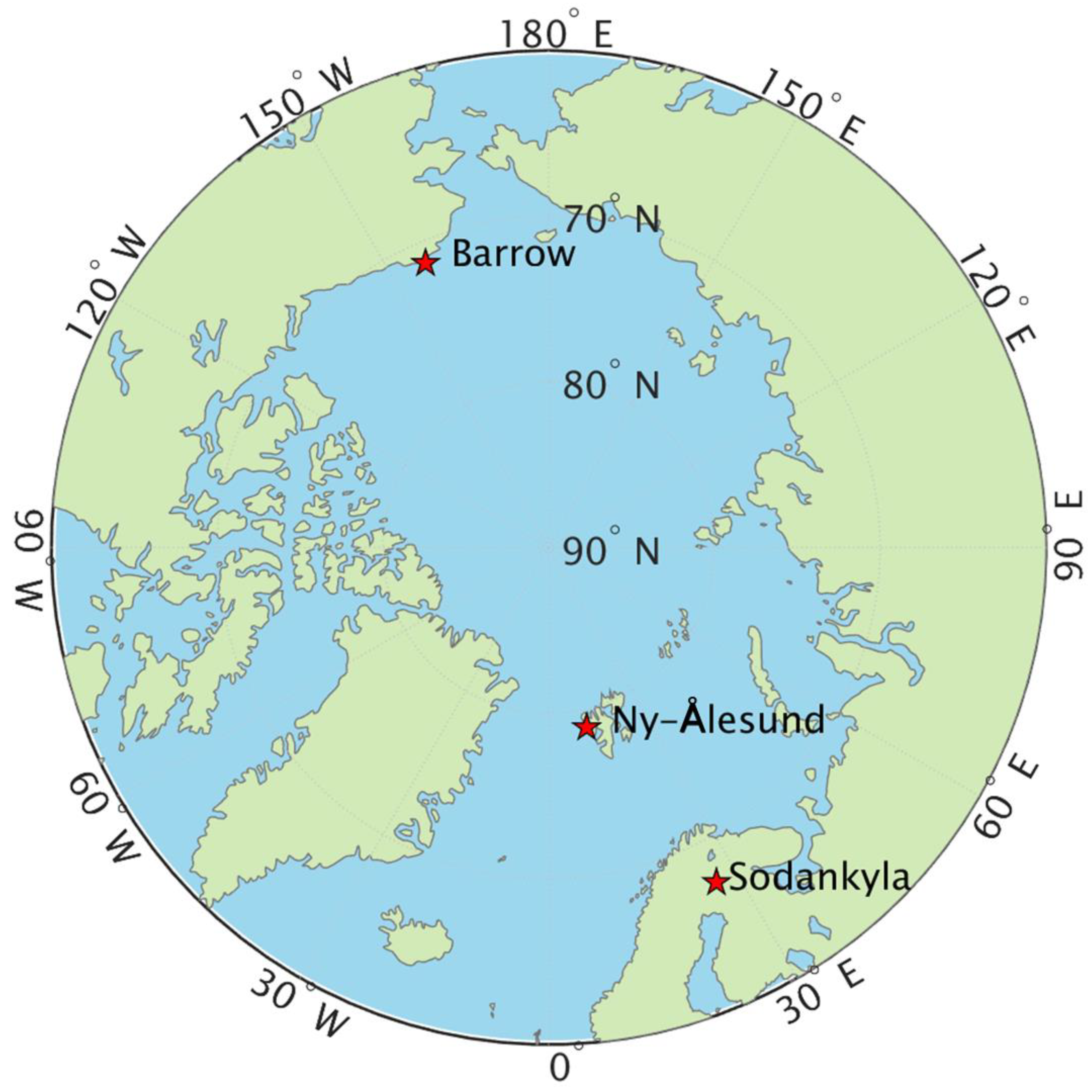

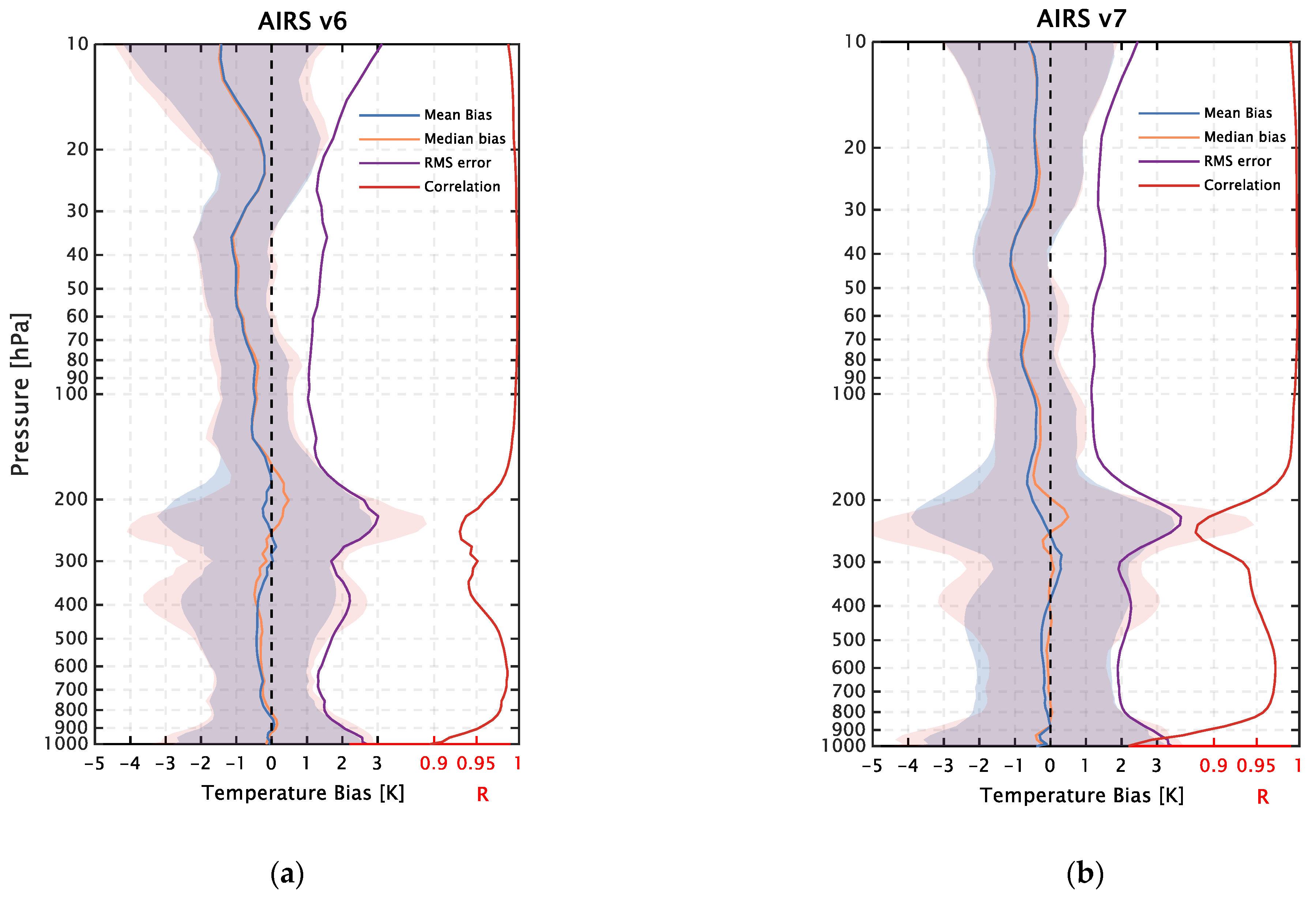
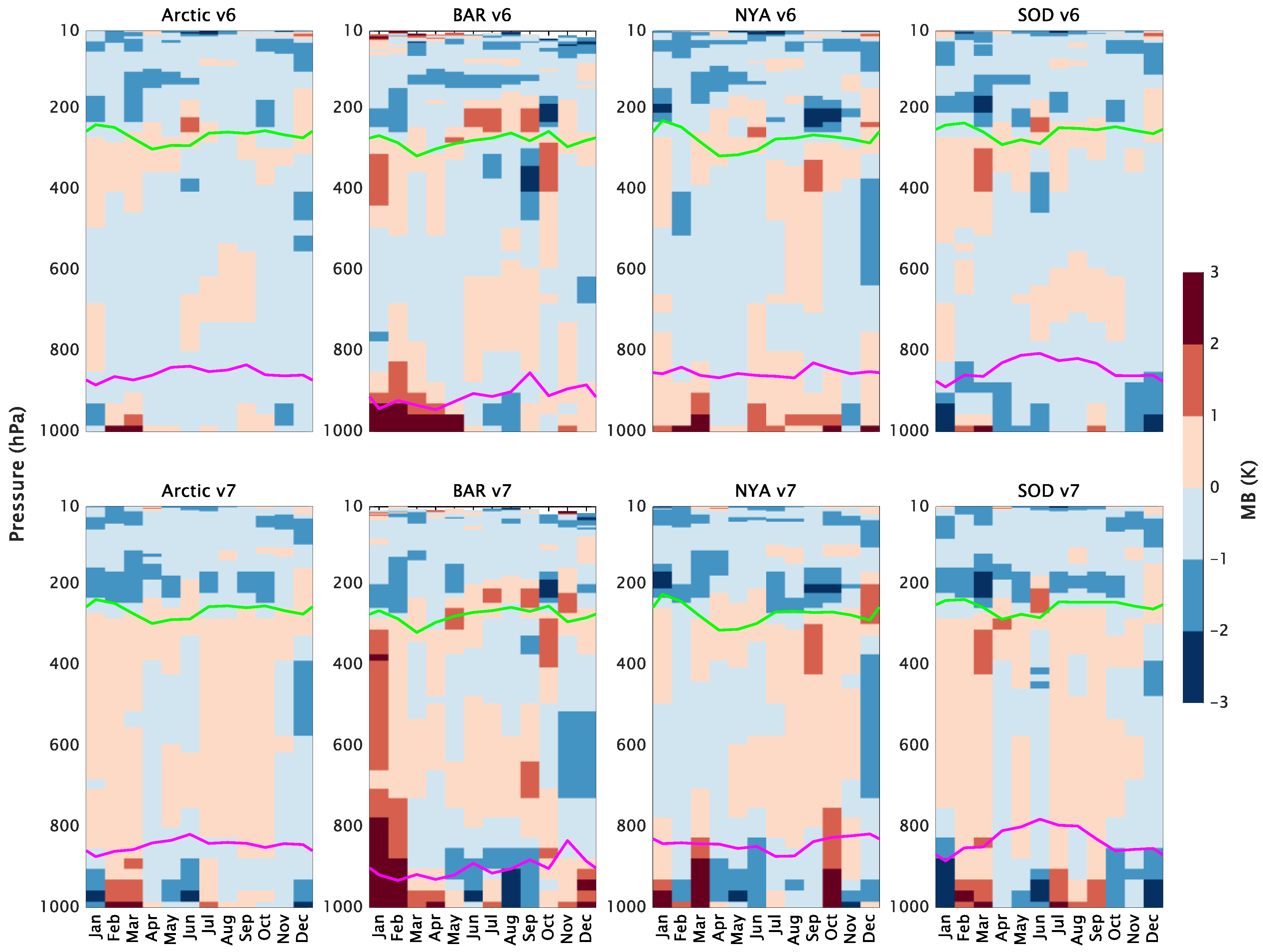
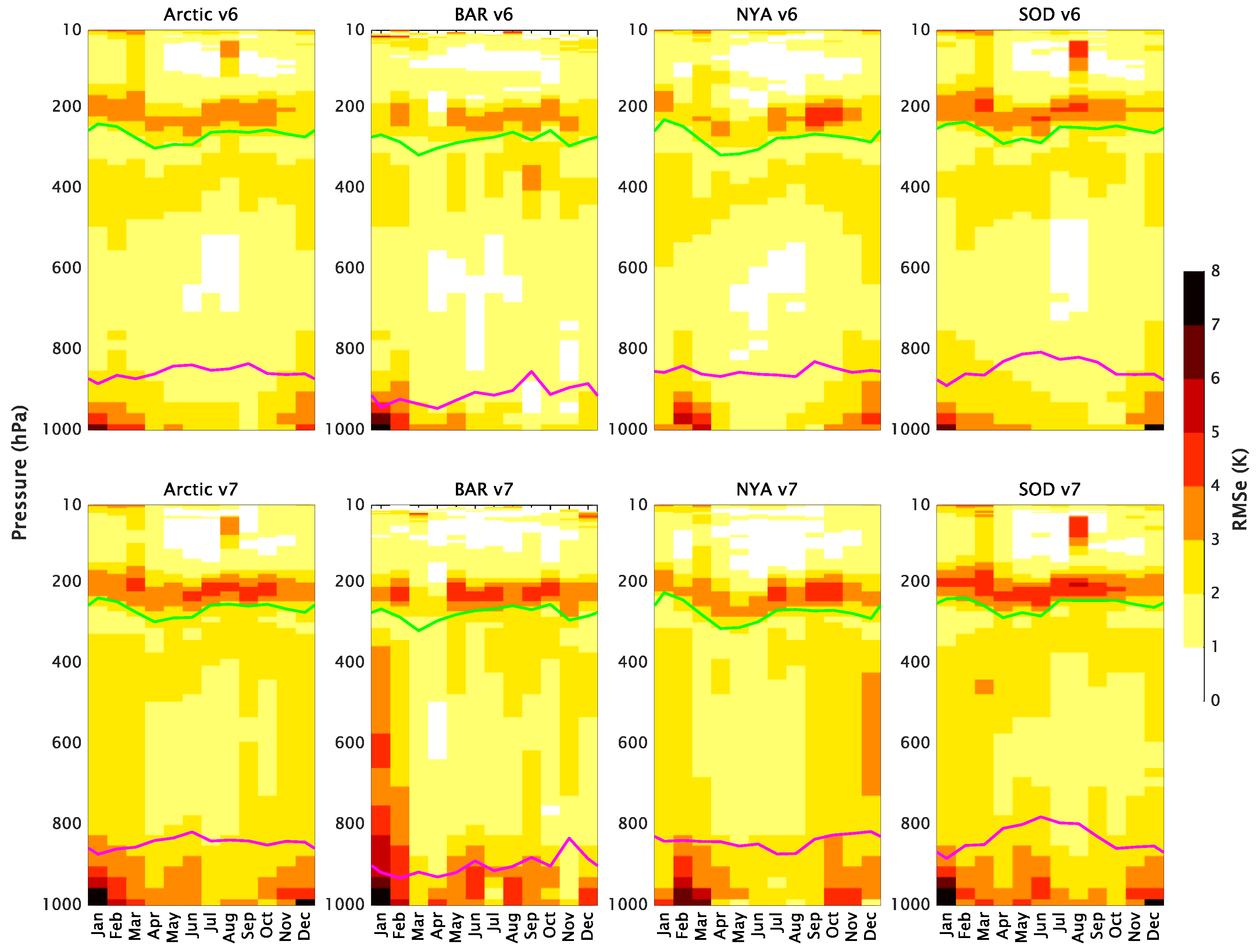

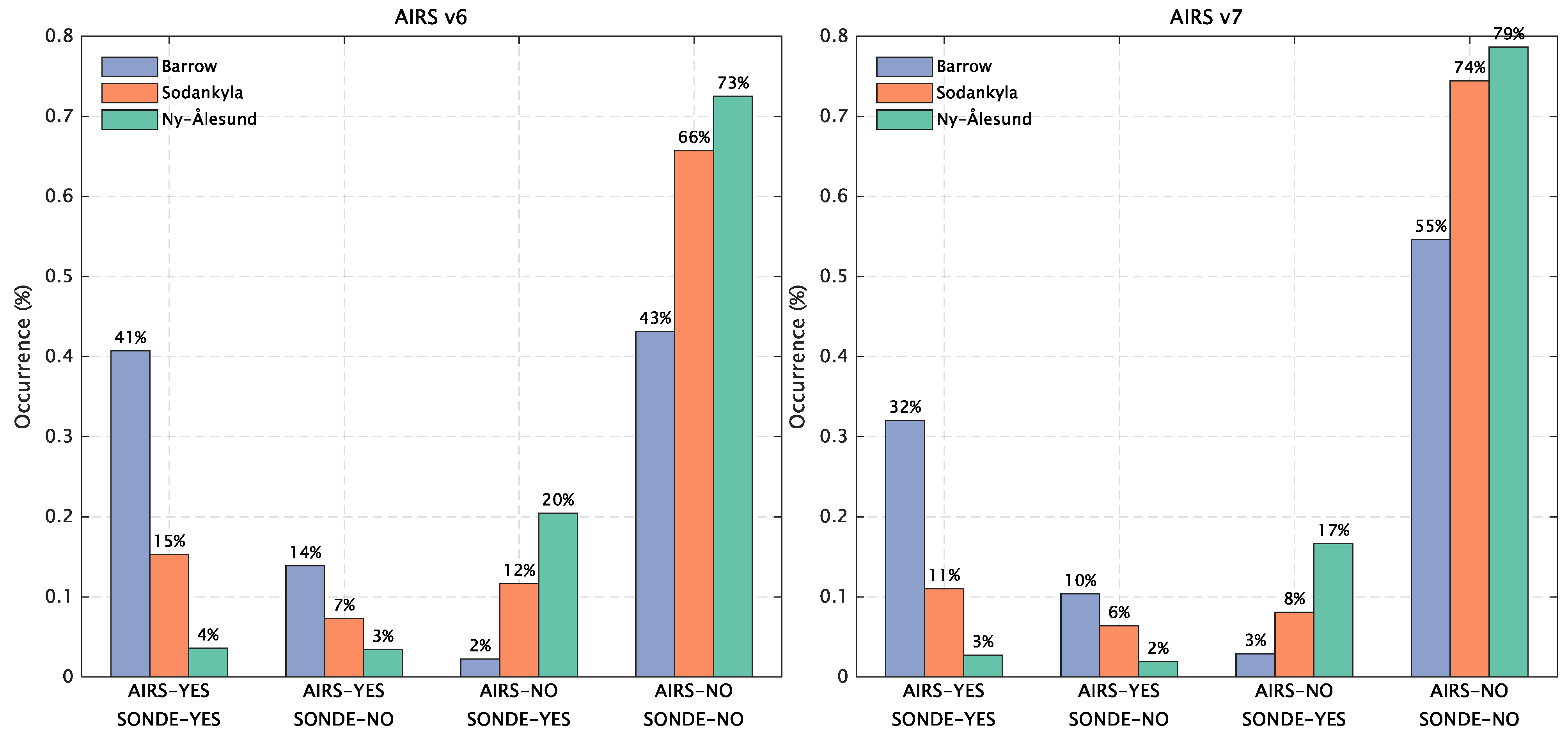
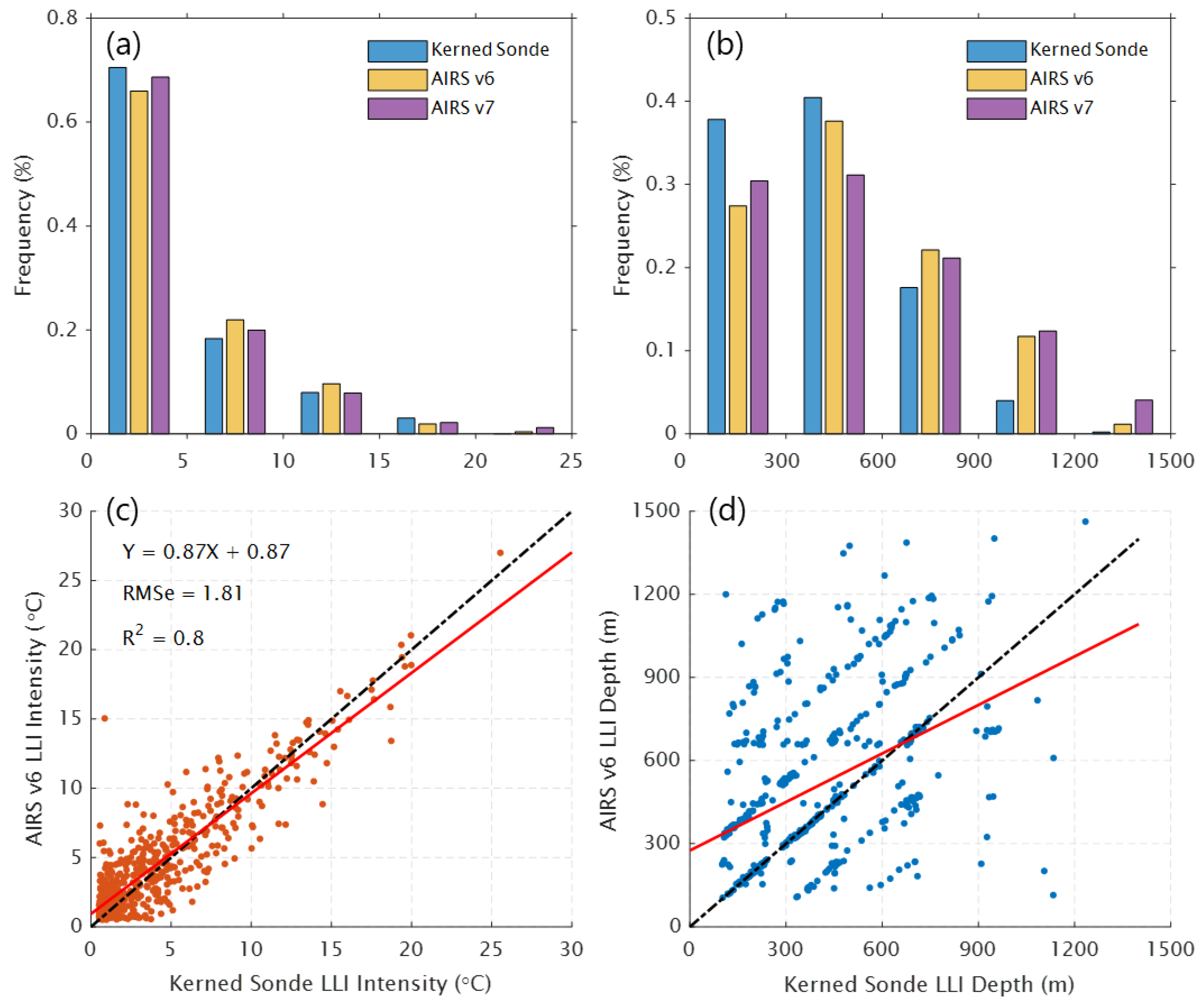
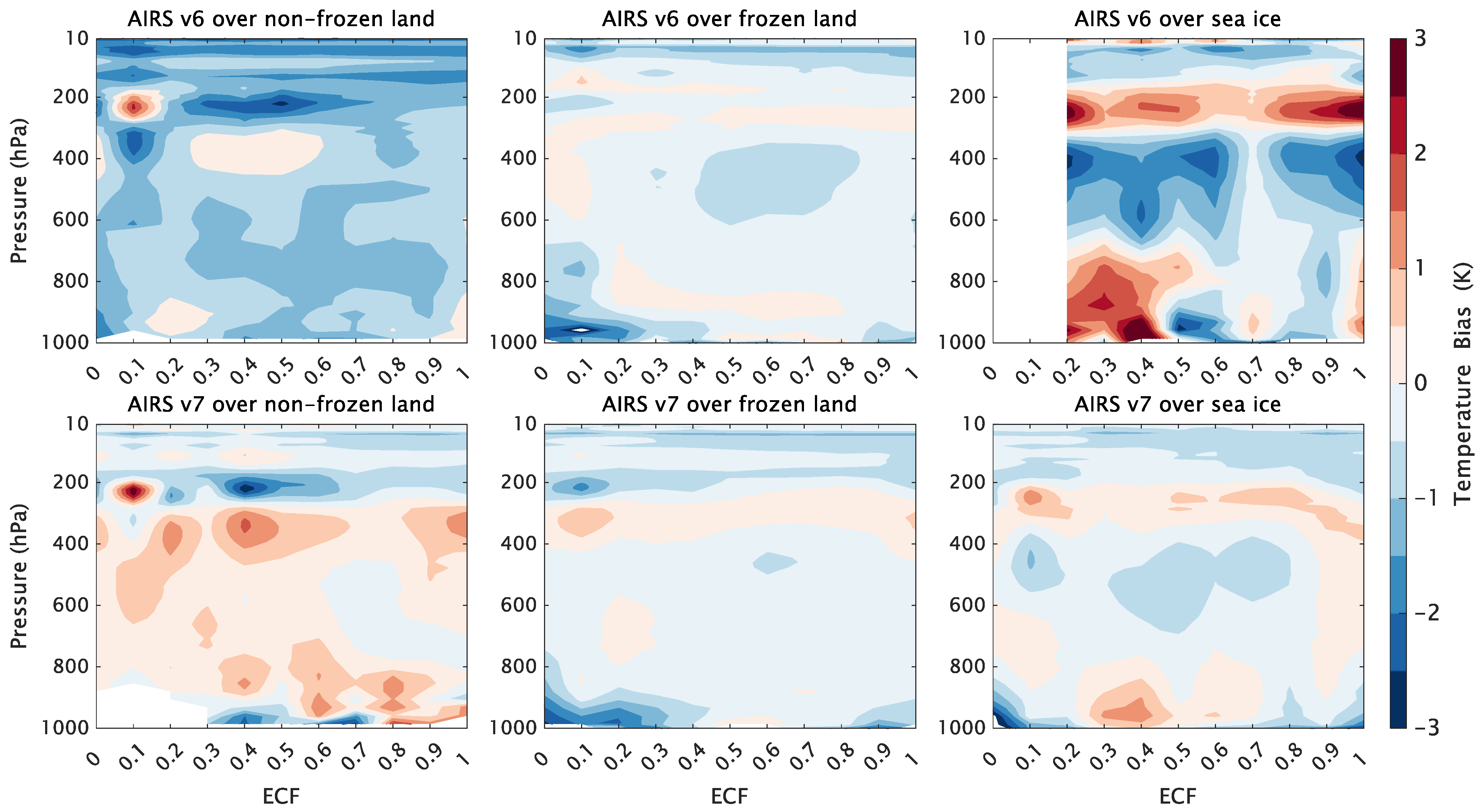
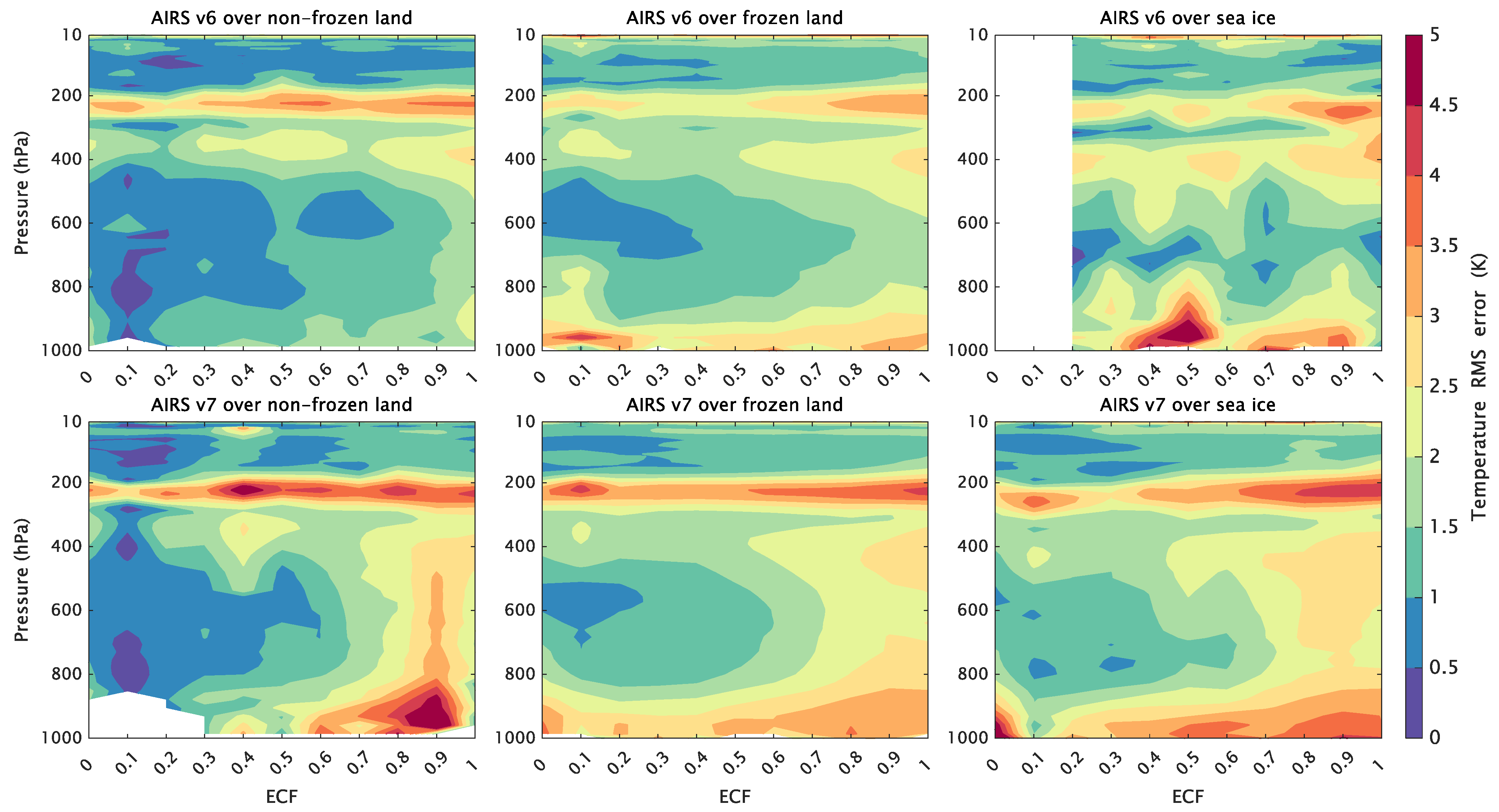
Disclaimer/Publisher’s Note: The statements, opinions and data contained in all publications are solely those of the individual author(s) and contributor(s) and not of MDPI and/or the editor(s). MDPI and/or the editor(s) disclaim responsibility for any injury to people or property resulting from any ideas, methods, instructions or products referred to in the content. |
© 2023 by the authors. Licensee MDPI, Basel, Switzerland. This article is an open access article distributed under the terms and conditions of the Creative Commons Attribution (CC BY) license (https://creativecommons.org/licenses/by/4.0/).
Share and Cite
Zhang, L.; Ding, M.; Zheng, X.; Chen, J.; Guo, J.; Bian, L. Assessment of AIRS Version 7 Temperature Profiles and Low-Level Inversions with GRUAN Radiosonde Observations in the Arctic. Remote Sens. 2023, 15, 1270. https://doi.org/10.3390/rs15051270
Zhang L, Ding M, Zheng X, Chen J, Guo J, Bian L. Assessment of AIRS Version 7 Temperature Profiles and Low-Level Inversions with GRUAN Radiosonde Observations in the Arctic. Remote Sensing. 2023; 15(5):1270. https://doi.org/10.3390/rs15051270
Chicago/Turabian StyleZhang, Lei, Minghu Ding, Xiangdong Zheng, Junming Chen, Jianping Guo, and Lingen Bian. 2023. "Assessment of AIRS Version 7 Temperature Profiles and Low-Level Inversions with GRUAN Radiosonde Observations in the Arctic" Remote Sensing 15, no. 5: 1270. https://doi.org/10.3390/rs15051270
APA StyleZhang, L., Ding, M., Zheng, X., Chen, J., Guo, J., & Bian, L. (2023). Assessment of AIRS Version 7 Temperature Profiles and Low-Level Inversions with GRUAN Radiosonde Observations in the Arctic. Remote Sensing, 15(5), 1270. https://doi.org/10.3390/rs15051270








